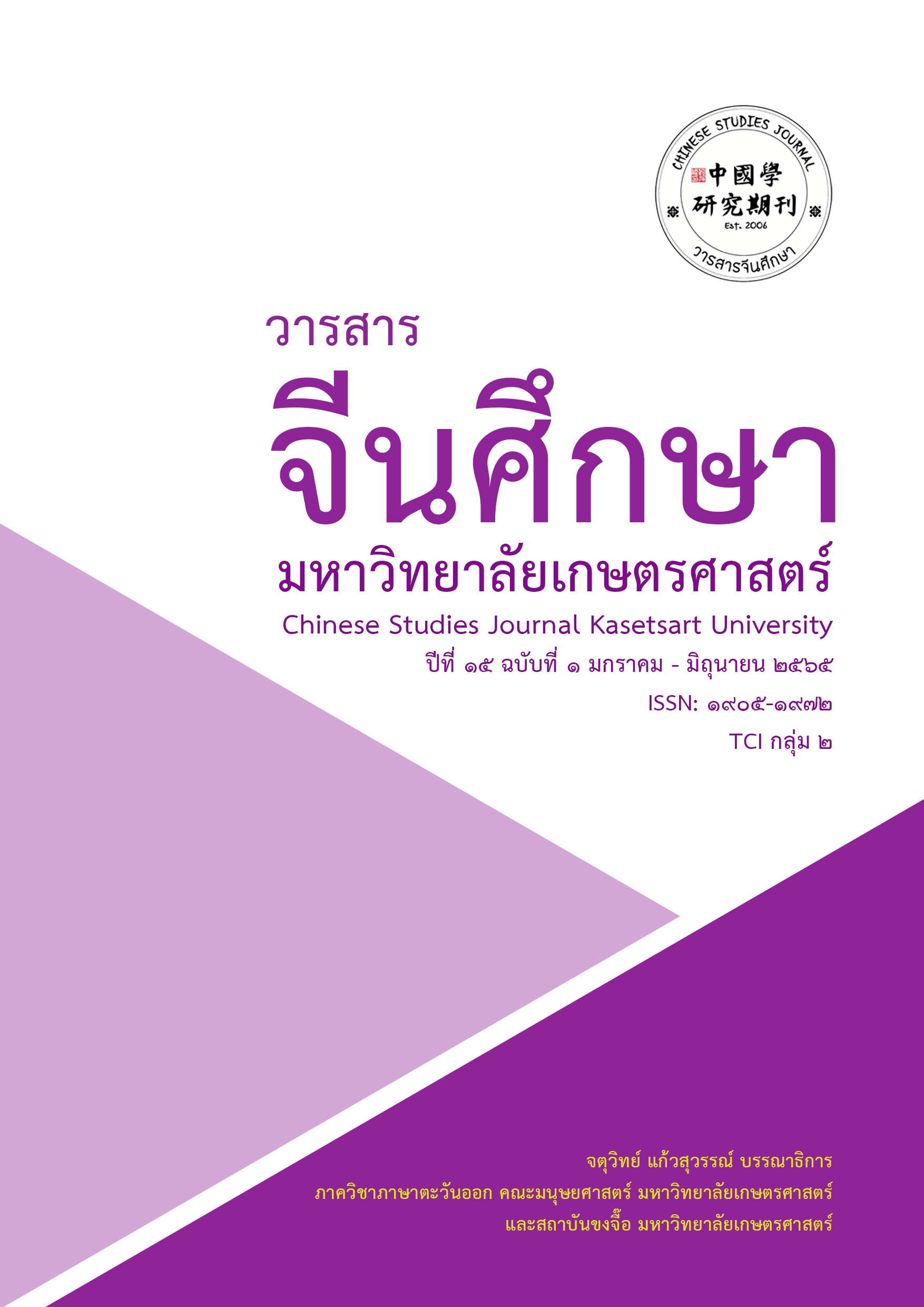A Longitudinal Study on the Acquisition of the Co-occurrence Construction of the Chinese adverb “Jiu” and the sentence final particle “Le” by Thai University Students การศึกษาติดตามการเรียนรู้รูปแบบร่วมในคำวิเศษณ์ “Jiu” และคำช่วยเสริมท้ายประโยค “Le” ในภาษาจีนของนักศึกษาไทย
Main Article Content
Abstract
: Based on the composition corpus of the same group of Thai university students in the second to fourth grades, this research investigates the usage and characteristics of the co-occurring constructions of the Chinese adverb “Jiu” and the sentence final particle “Le”, the types and distribution characteristics of errors, and the order of acquisition among Thai University students. problem. The results of the inspection show that: 1) The usage rate of the co-occurrence constructions by Thai University students is closely related to the composition style, the usage rate of the meanings of “Jiu” and the students’ composition level; 2) In general, the acquisition of the co-occurrence structure by Thai university students is relatively average, the overall error rate decreases linearly as the grade increases. they have learned that the distribution of the types of error of the co-occurrence constructions and the co-occurrence construction types which has errors are very concentrated. The presence or absence of “Le” in the co-occurring constructions is the difficulty for Thai university students to acquire various constructions; 3) Relatively speaking, the easiest co-occurrence construction for Thai university students to learn is “JL4.1”, and its accuracy rate has reached the standard of acquisition success. The co-occurrence constructions that are easier to learn but have not yet been successfully learned are “JL4.2, JL1, JL2, JL3.1”, and the two co-occurring constructions “JL3.2” and “JL3.3” become the relatively most difficult to learn constructions. Mode. This order of acquisition is basically consistent with the usage rates of the meanings of “Jiu” and the co-occurring constructions. Finally, based on the above research results, we have obtained the teaching enlightenment for the teaching of the co-occurring constructions of the adverb “Jiu” and the sentence final particle “le” for Thai university students.
Article Details

This work is licensed under a Creative Commons Attribution-NonCommercial-NoDerivatives 4.0 International License.
ผลงานทางวิชาการที่ลงตีพิมพ์ในวารสารจีนศึกษา มหาวิทยาลัยเกษตรศาสตร์ เป็นลิขสิทธิ์ของผู้เขียนหรือผู้แปลผลงานนั้น หากนำลงในวารสารจีนศึกษาเป็นครั้งแรก เจ้าของผลงานสามารถนำไปตีพิมพ์ซ้ำในวารสารหรือหนังสืออื่นได้โดยมิต้องแจ้งให้ทราบล่วงหน้า แต่หากผลงานที่ได้รับพิจารณานำลงในวารสารจีนศึกษา เป็นผลงานที่เคยตีพิมพ์ที่อื่นมาก่อนเจ้าของผลงานต้องจัดการเรื่องปัญหาลิขสิทธิ์กับแหล่งพิมพ์แรกเอง หากเกิดปัญหาทางกฎหมาย ถือว่าไม่อยู่ในความรับผิดชอบของวารสารจีนศึกษา มหาวิทยาลัยเกษตรศาสตร์ ทั้งนี้ ความคิดเห็นต่างๆ ในบทความเป็นความคิดเห็นส่วนตัวของผู้เขียน ไม่เกี่ยวกับกองบรรณาธิการวารสารจีนศึกษา มหาวิทยาลัยเกษตรศาสตร์
References
安福勇.(2015). 不同水平 CSL 学习者作文流畅性、句法复杂度和准确性分析——一项基于T单位测量法的研究.语言教学与研究,3,11-20.
陈佳宏.(2019).从量级衍推看“才”、“就”与句尾“了”的共现制约. 国际汉语学报,1,128-141.
陈俊光.(2008).对比分析与教学应用.台北.文鹤出版有限公司.
范立珂.(2009).副词“就”的三种句式的语义、语用分析.长沙大学 学报,6,106-108.
范立珂、陈忠.(2009).“就”与“了”的隐现问题:“衔接”义和“完成”义的“一致性”.社科纵横,9,92-94.
郭继懋、郑天刚.(2002).似同实异.北京.中国社会科学出版社.
黄露阳.(2009).外国留学生多义副词“就”的习得考察.语言教学与 研究,2,54-60.
金立鑫、于秀金.(2013).“就/才”句法结构与“了”的兼容性问题.汉语 学习,2013(3):3-14.
孟艳丽.(2010).“就”“才”及相关副词与句尾“了”共现的不对称现象 及成因.语言应用研究, 1,51-53.
李大忠.(1996).外国人学汉语语法偏误分析.北京.北京语言大学出版社.
刘林、陈振宇.(2015). 从与“了2”的共现关系谈汉语副词的意义类型. 语言教学与研究,5,102-112.
刘月华等.(2001).实用现代汉语语法(增订本).北京:商务印书馆.
吕叔湘.(1999).现代汉语八百词.北京:商务印书馆.
施家炜.(1998).外国留学生22类现代汉语句式的习得顺序研究.世界汉语 教学,4,77-98.
王青云.(2012).论副词“才”、“就”和语气助词“了”的共现.安徽职业技术学院学报,9,59-62.
王冬梅、姜炫先.(2015).从肯定和叙述的角度看副词“就、才”和句末“了、的”的共现.语言教学与研究,6,45-52.
王媚、张艳荣.(2007).俄罗斯留学生“了”字句使用偏误分析.云南师范 大学学报,5(1):47-51.
吴继峰、王亚琼.(2014). 第二语言习得顺序研究工具———蕴含量表评介.云南师范大学学报(对外汉语教学与研究版),12(1):40-47.
岳中奇.(2000).“才”、“就”句中“了”的对立分布与体意义的表述. 语文研究,3,19-27.
祝东平、王欣.(2008).“就”字句、“才”字句表主观量“早”、“晚”与“了”的隐现.宁夏大学学报,7,14-18.
张莹.(2012).认知视角下的“就”、才”主观性溯源兼论“就”、“才”中“了”的隐现.海外华文教育,1,39-45.
Brown, R. (1973) . A First Language: The Early Stages. Cambridge, Mass.: Harvard University Press.
Dulay, H., Burt, M. and Krashen, S. (1982). Language Two. New York: Oxford University Press.
Lai, H. L. (1995). Rejected Expectations: The scalar particles CAI and JIU in Mandarin Chinese. Pro-Quest Dissertations and Theses (PQDT), The University of Texas at Austin.
Lin, C. J. (2019). A Longitudinal Study of the Acquisition of Chinese Multi-Meaning Adverb “Jiu” by Thai University Students in the Native Language Environment. Journal of Humanities and Social Sciences, 7(2), 125-155.
Lyons, J. (1977). Semantics. Cambridge: Cambridge University Press.
Reichenbach, H. (1947). Elements of Symbolic Logic. New York: Free press.


